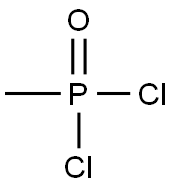메틸 포스폰 디염화물 C화학적 특성, 용도, 생산
화학적 성질
Methyl phosphonic dichloride is a low melting
solid or colorless to pale yellow liquid. Pungent odor.
용도
suzuki reaction
생산 방법
The oxidation of lowvalency organophosphorus compounds is important mainly in the case of the thiophosphonic acid chlorides. This method is used in the production of methylphosphonic acid dichloride by reaction of methyldichlorophosphine with sulfuryl chloride or chlorosulfuric acid. Elemental sulfur reacts with MePCl2 in the presence of catalytic quantities of tetraalkylphosphonium salts to form methylthiophosphonic acid dichloride.
일반 설명
Strongly irritates skin. Contact may destroy or irreversibly alter skin tissue. Very toxic by ingestion, inhalation, or by skin absorption. Combustible, though may be difficult to ignite.
공기와 물의 반응
Fumes in moist air to form hydrogen chloride. Reacts with water to form hydrochloric acid, reaction may be violent.
반응 프로필
METHYLPHOSPHONIC DICHLORIDE is incompatible with water, strong oxidizing agents, alcohols, bases (including amines).. May react vigorously or explosively if mixed with diisopropyl ether or other ethers in the presence of trace amounts of metal salts [J. Haz. Mat., 1981, 4, 291].
건강위험
Poisonous if inhaled or swallowed. Contact causes severe burns to skin and eyes.
화재위험
METHYLPHOSPHONIC DICHLORIDE may burn but does not ignite readily. May ignite other combustible materials (wood, paper, oil, etc.). Reacts violently with water. Flammable poisonous gases may accumulate in tanks and hopper cars. Runoff to sewer may create fire or explosion hazard. Contact causes severe burns to skin and eyes. Runoff from fire control or dilution water may cause pollution. Violent reaction with water.
Safety Profile
Poison by inhalation.
A corrosive irritant to the eyes, skin,
and mucous membranes. When heated
to decomposition it emits toxic fumes
of Cland POx.
잠재적 노출
Highly flammable; mists or Vapors may
form explosive mixture with air. Reacts with moist air forming
fumes of hydrogen chloride; may spontaneously ignite. Reacts
with water or alcohol, forming hydrochloric acid. The reaction
may be violent and ignite unreacted material. Incompatible
with oxidizers (chlorates, nitrates, peroxides, permanganates,
perchlorates, chlorine, bromine, fluorine, etc.); contact may cause fires or explosions. Keep away from alkaline materials,
strong bases, strong acids, oxoacids, epoxides, amines, ethers.
May react violently, possibly explosively, when mixed with
ethers and trace amounts of metal salts.
운송 방법
UN9206 Methyl phosphonic dichloride, Hazard
class: 6.1; Labels: 6.1-Poisonous materials, 8-Corrosive
material. Domestic (United States), Inhalation Hazard Zone
B. UN3390 Toxic by inhalation liquid, corrosive, n.o.s.
with an LC50 # 1000 mL/m3 and saturated vapor concentration ≥ 10 LC50 Hazard Class: 6.1; Labels: 6.1-
Poisonous materials, 8-Corrosive material, Technical Name
Required, Inhalation Hazard Zone B
Purification Methods
Methylphosphonic dichloride [676-97-1] M 132.9, m 33o, 33-37o, b 53-54o/10mm, 64-6 7o/20.5mm, 86o/44mm, 162o/760mm, d 4 1.4382. Fractionally redistil it until the purity as checked by hydrolysis and acidimetry for Clis correct and the distillate should solidify on cooling. [Kinnear & Perren J Chem Soc 3437 1952, Crofts & Kosolapoff J Am Chem Soc 75 3379 1952, for IR see McIvor et al. Can J Chem 34 1611 1956, Beilstein 4 IV 3509.]
폐기물 처리
Use a licensed professional
waste disposal service to dispose of this material. Dissolve
or mix the material with a combustible solvent and burn
in a chemical incinerator equipped with an afterburner and
scrubber. All federal, state, and local environmental
regulations must be observed
메틸 포스폰 디염화물 준비 용품 및 원자재
원자재
준비 용품








